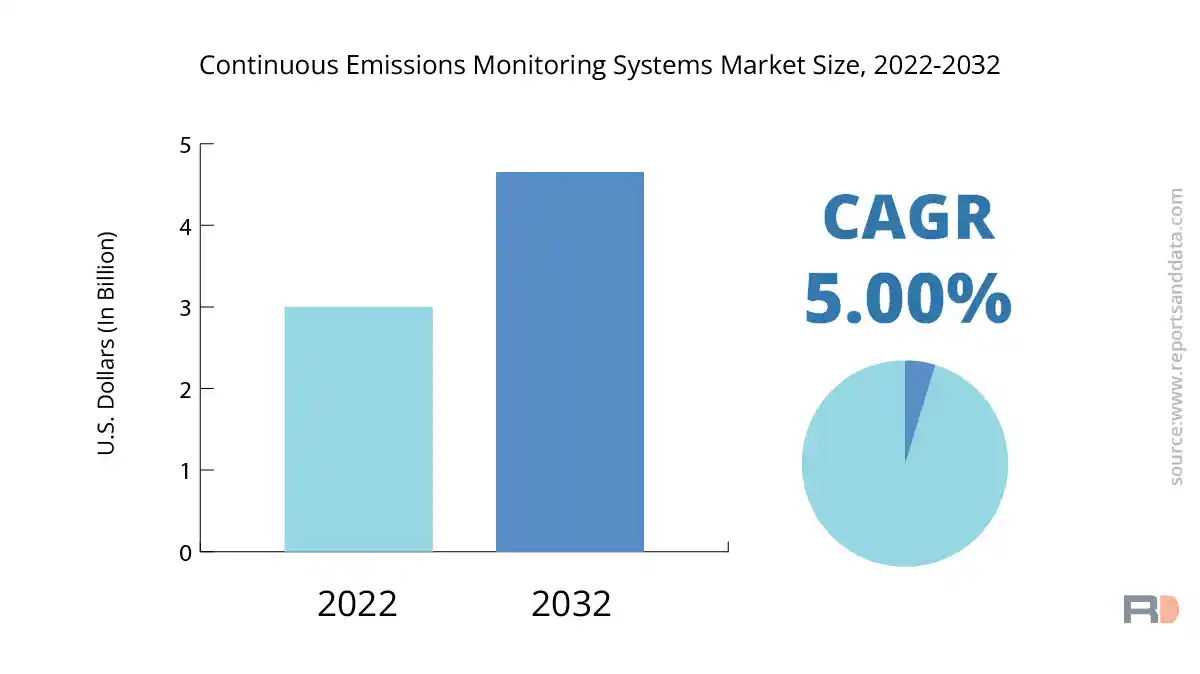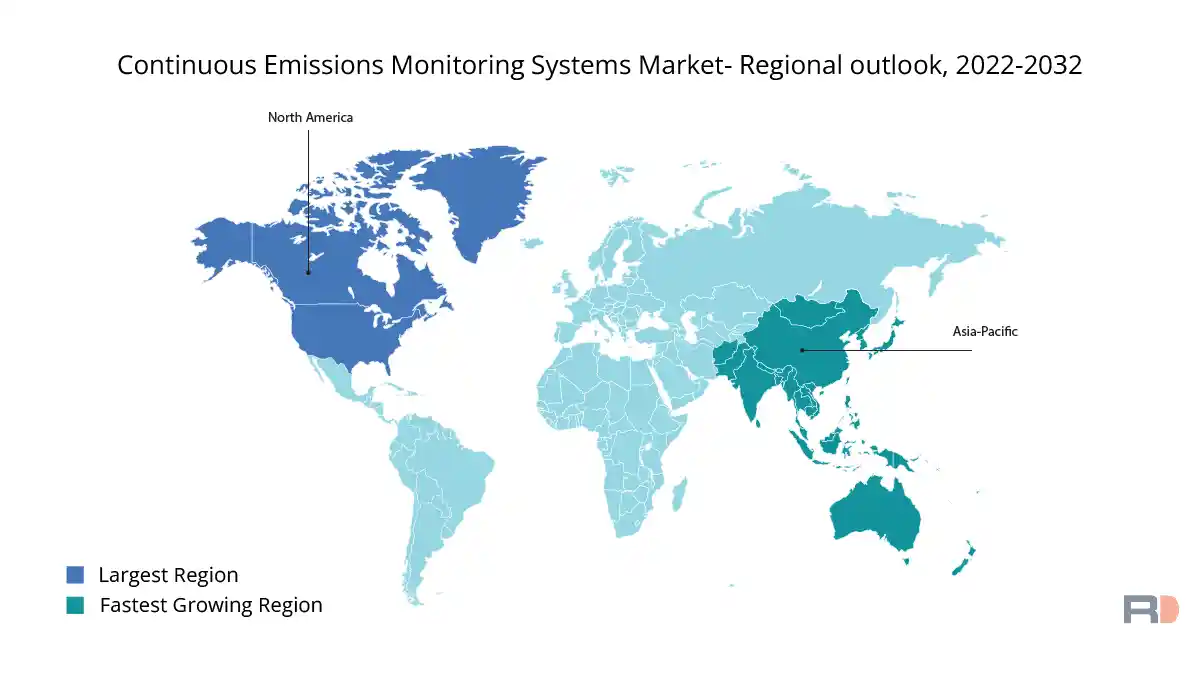Want to curate the report according to your business needs
Report Description + Table of Content + Company Profiles

The market value for Continuous Emissions Monitoring Systems (CEMS) Market was USD 3 Billion in 2022 and is expected to reach USD 4.65 Billion in 2032 growing at a CAGR of 5% during the forecast period. The CEMS Market is being pushed primarily by rising government laws about emissions monitoring, the rising need for efficient and effective air pollution control systems, and rising environmental awareness.
Continuous emissions monitoring systems are in high demand in a variety of industries, including power generation, oil and gas, Cement, chemicals, and metals and mining. These businesses are substantial contributors to greenhouse gas emissions and air pollution, both of which have negative consequences for human health and the environment.

Governments all over the world are putting in place stringent measures to monitor and limit these emissions. For example, under the Clean Air Act (CAA), the United States Environmental Protection Agency (EPA) has regulated the use of CEMS for certain businesses to limit the emission of pollutants such as sulfur dioxide, nitrogen oxides, and particulate matter.
The growing demand for efficient and effective air pollution control systems is also driving the CEMS industry forward. The growing knowledge of the negative impacts of air pollution on human health and the environment has resulted in the implementation of air pollution control systems, including continuous emissions monitoring systems. These systems assist enterprises in monitoring and controlling emissions, assuring regulatory compliance, and lowering environmental impact.
Technological advances in continuous emissions monitoring systems are also helping to drive market expansion. Manufacturers are constantly inventing new and innovative CEMS systems to suit the changing needs of diverse industries. For example, the combination of CEMS with IoT technology and Artificial Intelligence enables real-time pollution monitoring and Predictive Analytics to identify possible hazards before they arise.
Increasing industrialization, urbanization, and government measures to reduce emissions are projected to fuel considerable expansion in the Asia-Pacific region’s CEMS market over the forecast period. The Indian government, for example, has developed the National Clean Air Programme (NCAP) to reduce air pollution in the country. Installation of CEMS in industries to monitor and control emissions is part of the program.
The COVID-19 pandemic has had an uneven impact on the CEMS sector. On the one hand, the pandemic has caused industry shutdowns and decreased economic activity, resulting in a drop in demand for CEMS. On the other side, the pandemic has highlighted the need for environmental protection and air pollution management, which will increase long-term demand for CEMS.
However, the CEMS market’s expansion is hampered by several problems, including expensive installation and maintenance costs, a scarcity of competent employees, and the availability of competing technologies. Furthermore, the complexity of the monitoring procedure, as well as the necessity for accuracy and precision in emissions data gathering, constitute a barrier to CEMS implementation in particular industries.
The global CEMS Market is segmented into three major components: hardware, software, and services. These components are crucial in monitoring and reporting emissions from a variety of industries, including oil and gas, power generation, and chemical manufacturing.
During the forecast period, the hardware segment of the CEMS market is estimated to account for a sizable proportion of revenue. This might be attributable to the growing demand for accurate, dependable, and effective pollution monitoring technologies. The hardware component is made up of various sensors, probes, and analyzers that are used to determine the concentration of contaminants in the atmosphere. Gas Analyzers, Gas Sampling Systems, Data Acquisition Systems, Flow and Opacity Monitors, and others comprise the hardware section. The growing number of laws enforced by governments and environmental agencies to prevent pollution and minimize emissions is also driving growth in the hardware segment.
During the forecast period, the software component of the CEMS market is predicted to have the greatest revenue CAGR. This expansion is being driven mostly by the increased usage of cloud-based software solutions and advances in data analytics technologies. Data management software, calibration software, reporting software, and other applications are included in the software segment. These software systems monitor emissions in real-time and give precise data for analysis and reporting. Furthermore, cloud-based software solutions provide cost-effectiveness, scalability, and flexibility in terms of data access from any location, at any time. The requirement for remote monitoring is also driving the deployment of these software solutions, particularly during the COVID-19 outbreak, which has resulted in limited physical access to installations.
Installation, maintenance, and training services are all part of the CEMS market’s services segment. Due to the rising requirement for frequent maintenance and calibration of CEMS systems to provide accurate and reliable emissions measurements, this market is likely to increase significantly throughout the forecast period. Furthermore, the growing awareness of the benefits of CEMS systems, as well as the requirement for training to properly operate and manage these systems, are driving demand for services.
Continuous Emissions Monitoring Systems (CEMS) are used to monitor, record, and report emissions from a variety of sectors. The system is made up of three parts: hardware, software, and services. CEMS are widely utilized in a variety of industries, including power generation, oil and gas, chemical and petrochemical, and others. The global Continuous Emissions Monitoring Systems market is divided into three technology segments: opacity & dust, oxygen, NOx, SO2, and others.
The global CEMS Market is likely to be led by the opacity & dust segment. This market is likely to expand as environmental rules become more stringent around the world. Governments all over the world have enacted various environmental restrictions to decrease industrial emissions. For example, in the U.S., the Clean Air Act (CAA) and in Europe, the Industrial Emissions Directive (IED) mandate enterprises to install CEMS to monitor and report their emissions. Furthermore, rising electricity consumption and an increase in the number of coal-fired power plants in developing nations such as India and China are driving growth in the opacity & dust market.
During the forecast period, the oxygen segment is also expected to develop significantly. In industries such as power generation, oil and gas, and chemical and petrochemical, oxygen measurement is critical. Oxygen measurement aids in maintaining boiler combustion efficiency, reducing fuel use, and lowering pollutants. The growing need for energy and the expanding number of power plants around the world are likely to drive the oxygen segment forward.
During the projection period, the NOx segment is expected to develop significantly. NOx is a serious air pollutant, and NOx emissions from industry are strictly regulated by governments all over the world. The NOx segment is predicted to develop as environmental rules become more stringent and enterprises become more conscious of the adverse impacts of NOx emissions.
During the projection period, the SO2 segment is also expected to rise. SO2 is a major air pollutant produced by sectors such as electricity generation, chemical, and petrochemical manufacturing. Environmental restrictions such as the Acid Rain Programme in the United States and the Large Combustion Plant Directive in Europe, which mandate industry minimize SO2 emissions, are likely to drive the SO2 segment’s growth.
Other factors include Carbon Monoxide (CO), Ammonia (NH3), and Hydrogen Chloride (HCl). The others segment is predicted to rise as industries become more conscious of the adverse impacts of these pollutants and environmental restrictions become more stringent.
During the projected period, the North American market is expected to dominate the CEMS Market in terms of revenue share. Stringent government regulations and a growing emphasis on environmental protection in the region are the key drivers of this market expansion. Furthermore, the presence of numerous significant manufacturers in the region is projected to fuel the market even further. To decrease air pollution, the United States Environmental Protection Agency (EPA) requires the use of continuous emissions monitoring devices in a variety of businesses, including power generation, cement, and petrochemicals. North American demand for CEMS is likely to increase as a result of the rules.
During the projected period, the Europe market for CEMS is also expected to rise significantly. The European Union (EU) has imposed severe emission limits to reduce air pollution, which is increasing the region’s need for CEMS. The European Union Emissions Trading System (EU ETS) is one of the most comprehensive and ambitious carbon trading systems in the world, and it is helping to build the European CEMS market. Furthermore, the region’s growing power generation, chemical, and manufacturing industries are likely to drive CEMS demand even higher.
During the projected period, the Asia Pacific region is expected to experience the fastest growth in the CEMS market. The region’s increasing industrialization and urbanization can be ascribed to the region’s expansion. Rapid industrialization has resulted in considerable environmental concerns and government legislation to control pollution in nations such as China, India, and Japan. The region’s need for CEMS is being driven by the adoption of emission control measures. Furthermore, the region’s transition to Renewable Energy sources is likely to raise demand for CEMS to monitor and manage emissions from these sources.

The global CEMS Market is highly competitive, with several large and medium-sized players accounting for a majority of market revenue. Major players are deploying various strategies, including mergers & acquisitions, strategic agreements & contracts, developing, testing, and introducing more effective products. Some major companies included in the global CEMS market report are:
| PARAMETERS | DETAILS |
| The market size value in 2022 | USD 3 Billion |
| CAGR (2022 - 2032) | 5% |
| The Revenue forecast in 2032 |
USD 4.65 Billion |
| Base year for estimation | 2022 |
| Historical data | 2020-2021 |
| Forecast period | 2022-2032 |
| Quantitative units |
|
| Report coverage | Revenue forecast, company ranking, competitive landscape, growth factors, and trends |
| Segments covered | By Component Outlook, Technology Outlook, Application Outlook, Regional Outlook |
| By Component Outlook |
|
| By Technology Outlook |
|
| By Application Outlook |
|
| Regional scope | North America; Europe; Asia Pacific; Latin America ; Middle East & Africa |
| Country scope | U.S.; Canada; U.K.; Germany; France; BENELUX; China; India; Japan; South Korea; Brazil; Saudi Arabia; UAE; Turkey |
| Key companies profiled | ABB Ltd, Emerson Electric Co, General Electric Company, Siemens AG, Teledyne Technologies Incorporated, Thermo Fisher Scientific Inc, HORIBA Ltd, Opsis AB, Environnement SA, AMETEK Inc. |
| Customization scope | 10 hrs of free customization and expert consultation |
Facing issues finding the exact research to meet your business needs? Let us help you! One of our Research Executives will help you locate the research study that will answer your concerns. Speak to Analyst Request for Customization
Request a FREE Sample here to understand what more we have to offer over competition…
upto20% OFF
upto20% OFF
Want to curate the report according to your business needs
Report Description + Table of Content + Company Profiles
